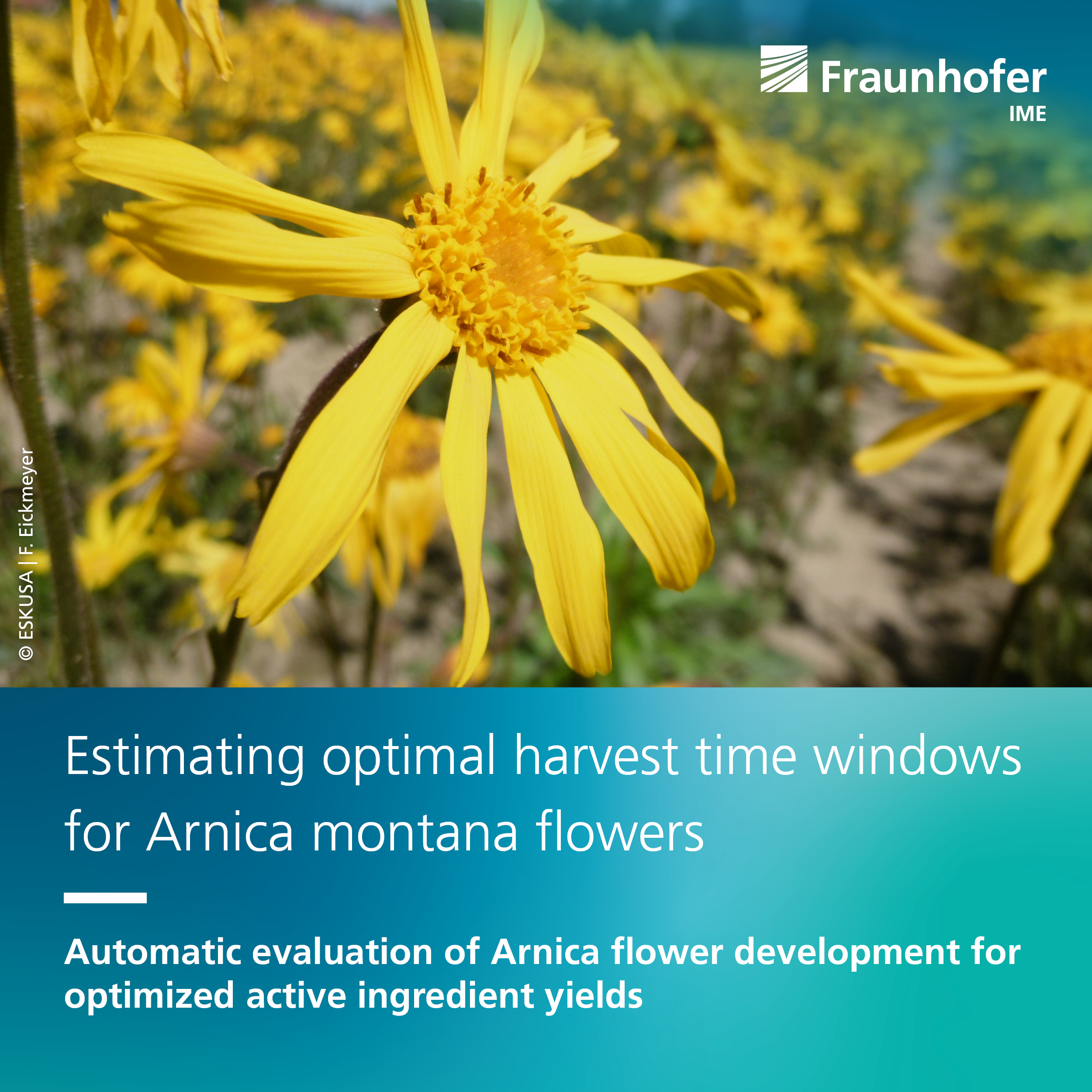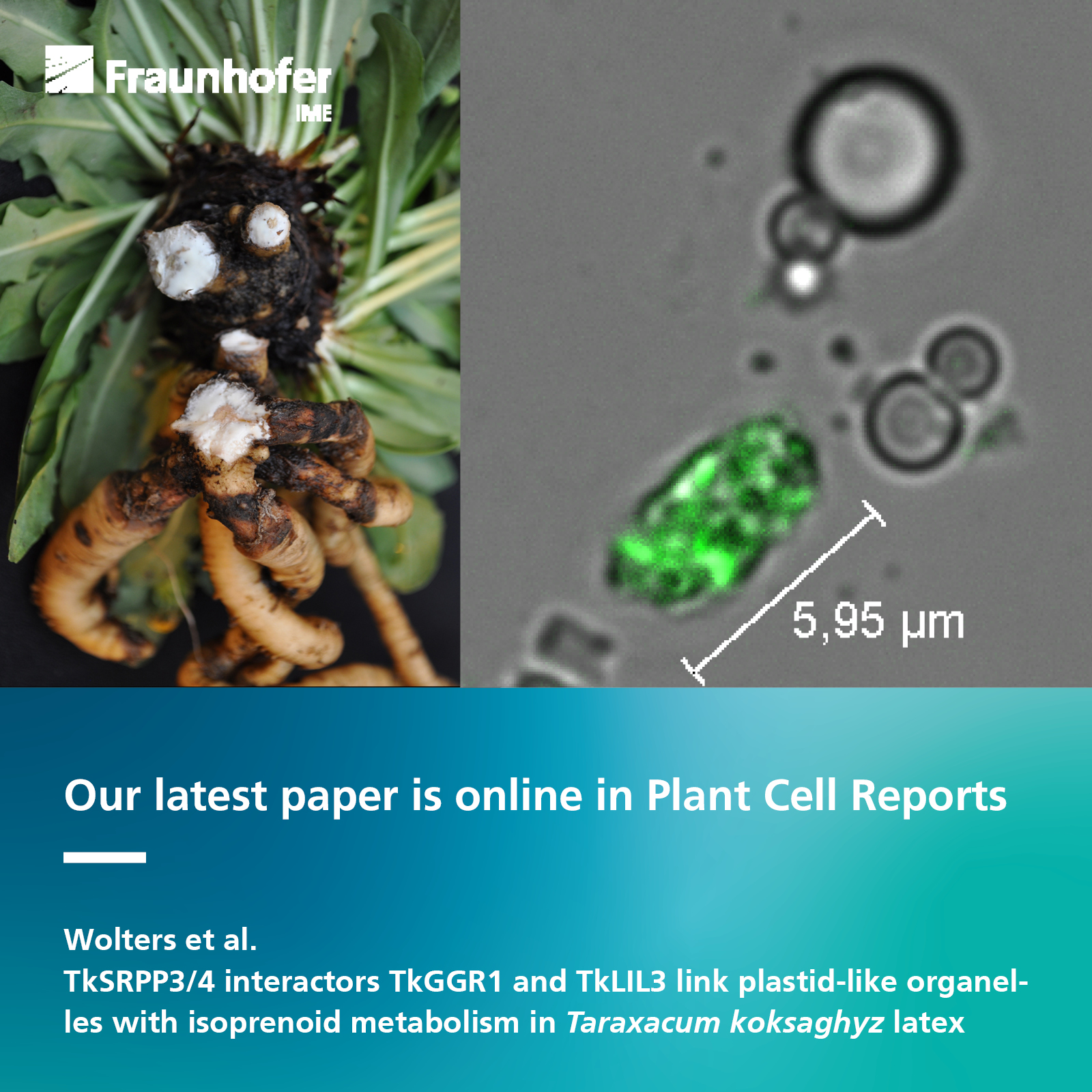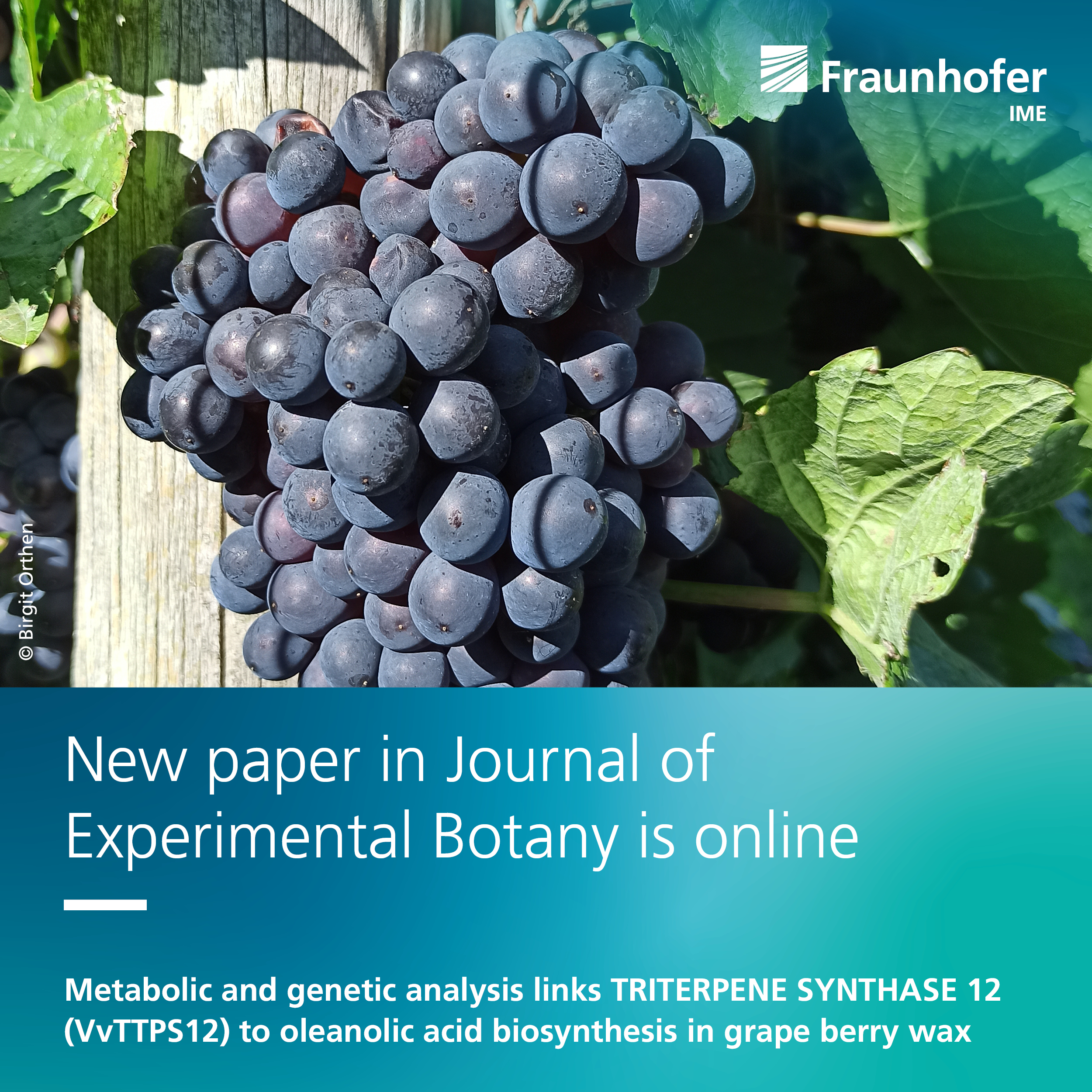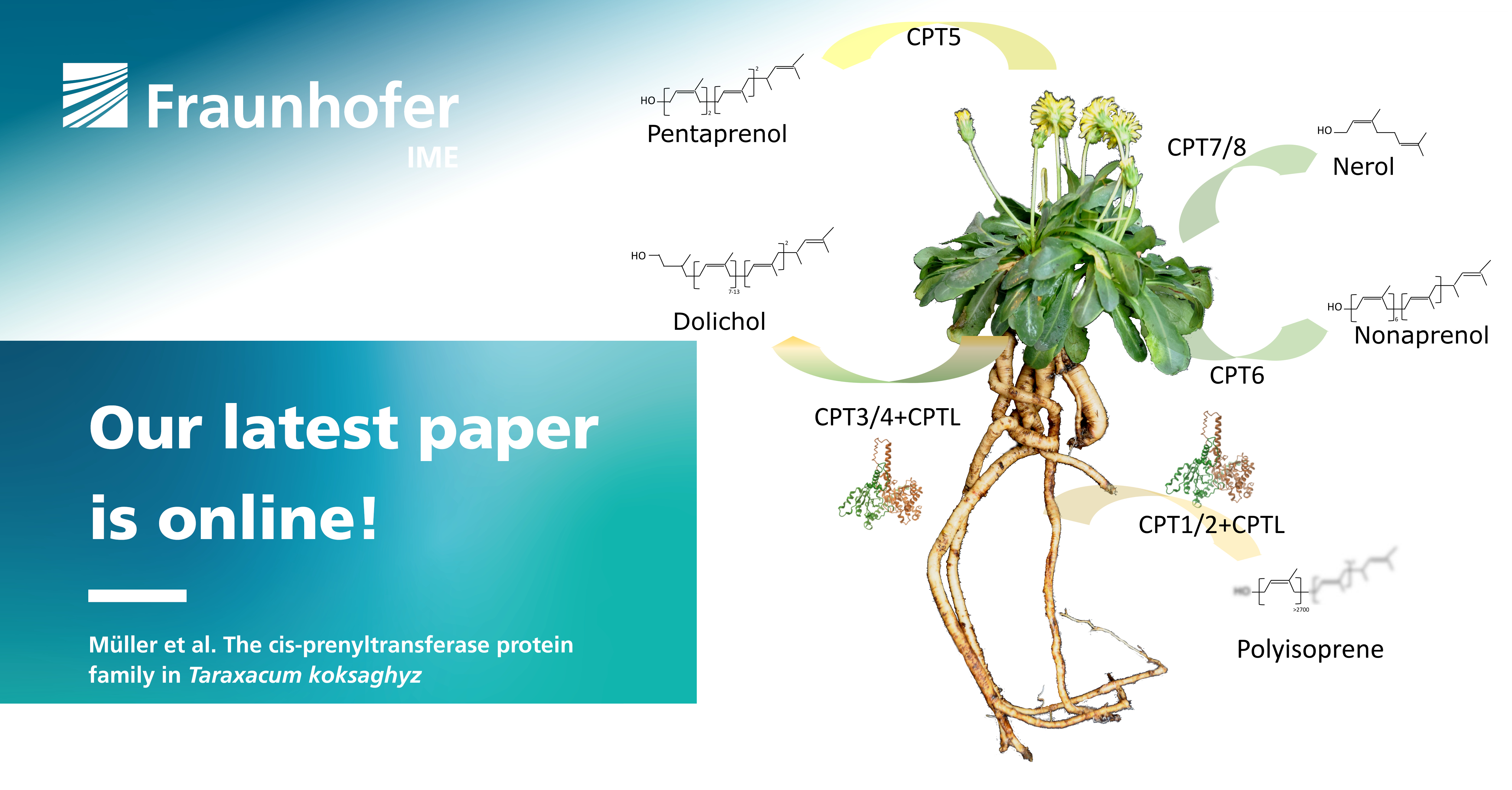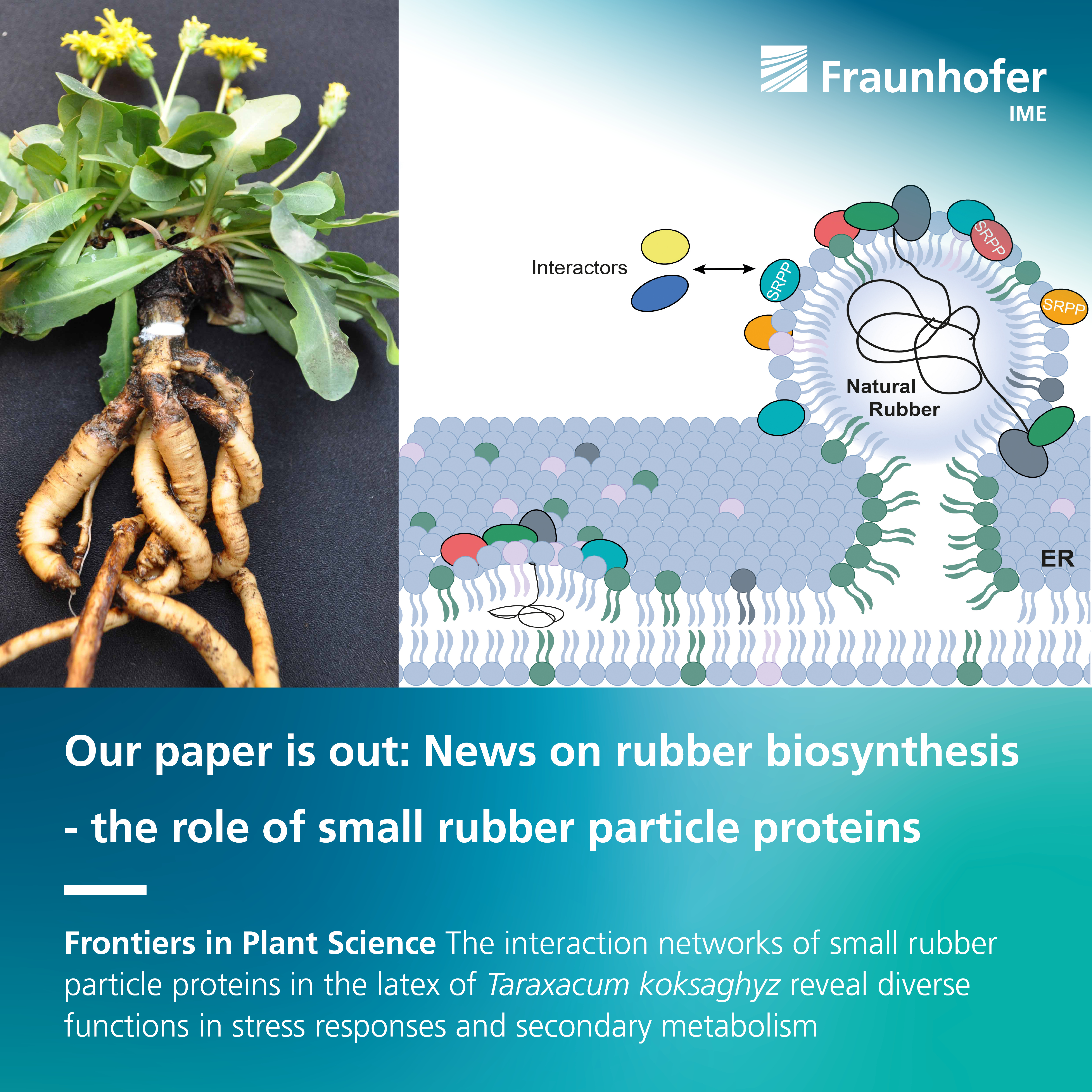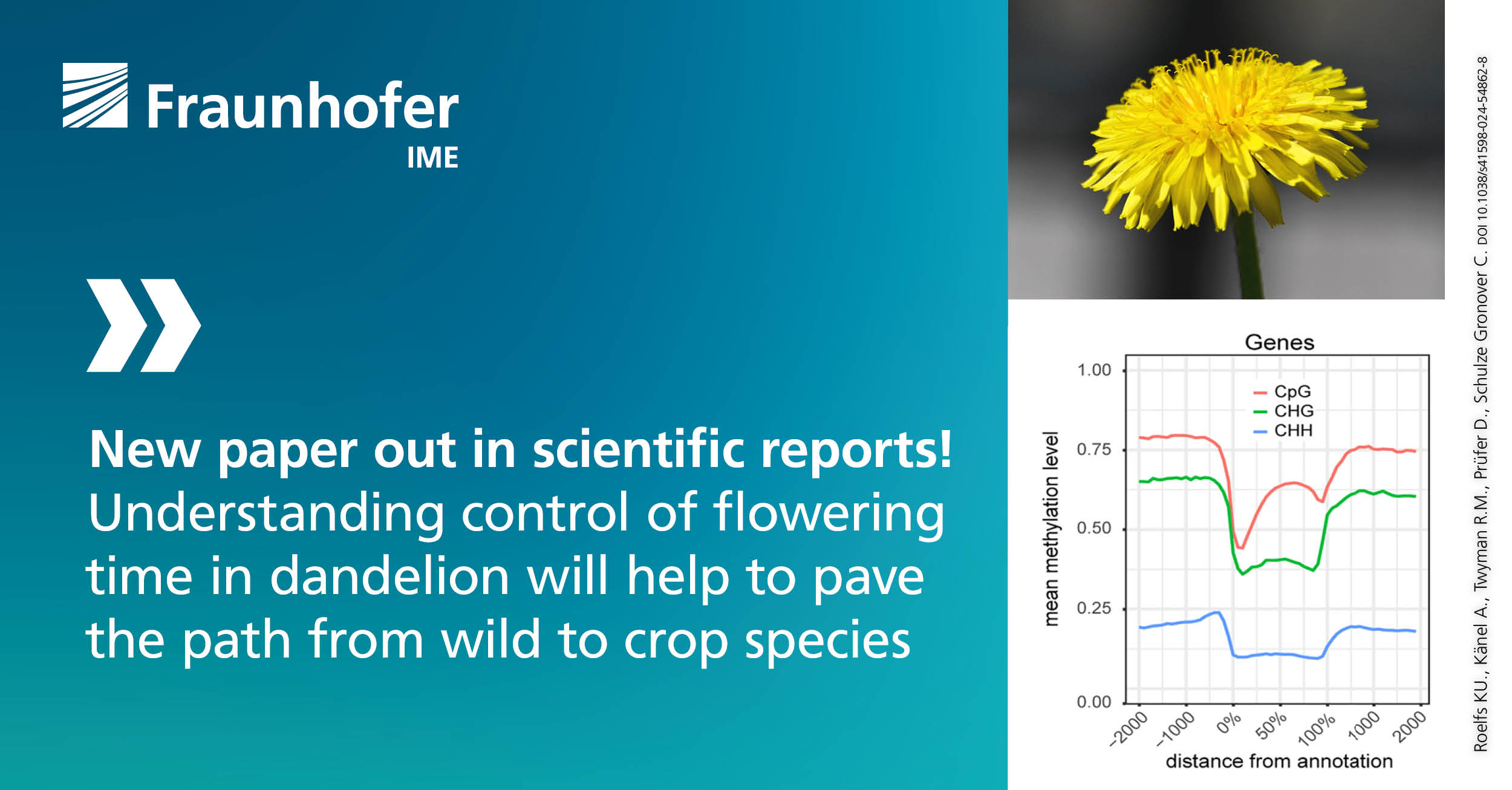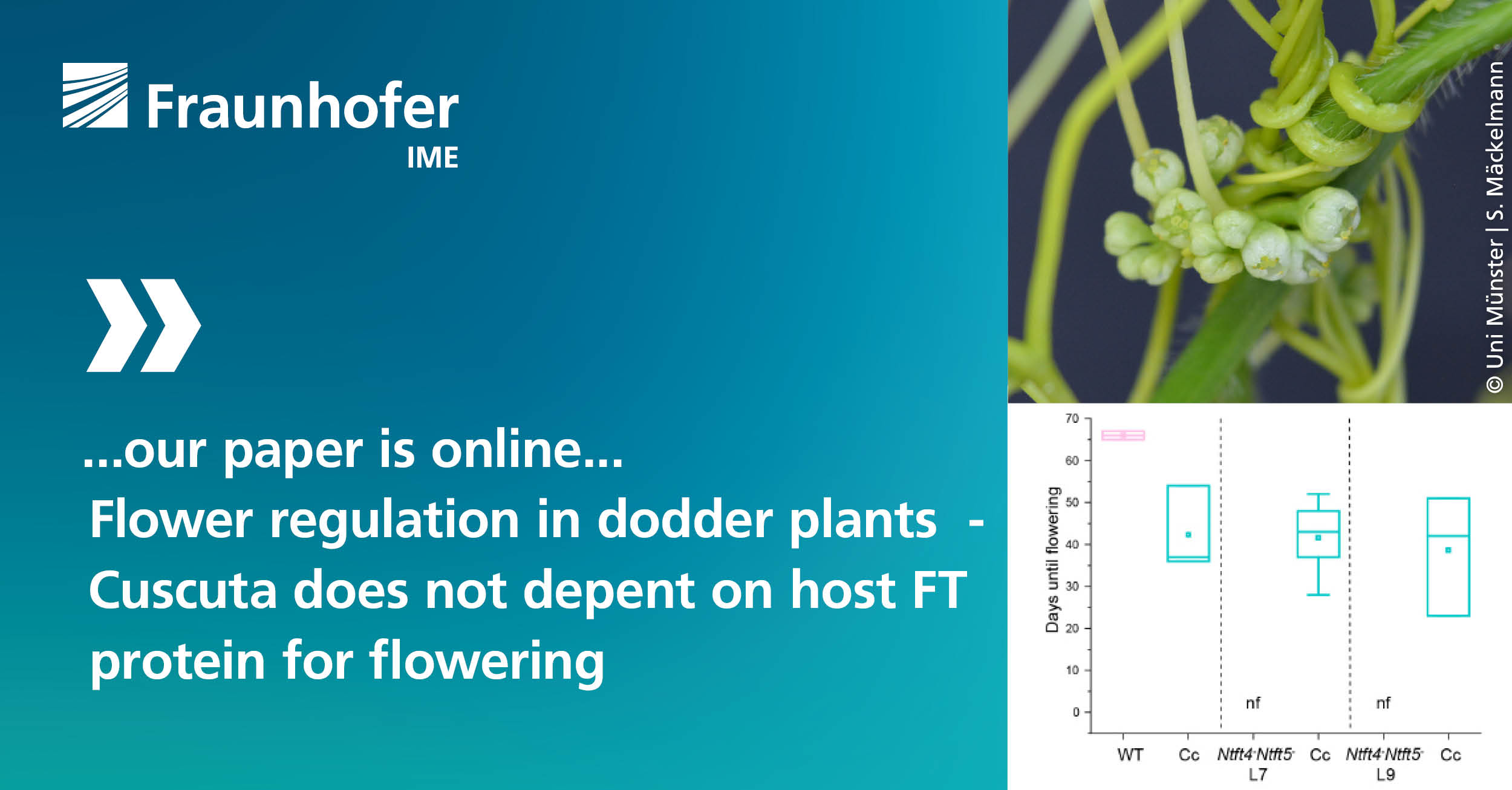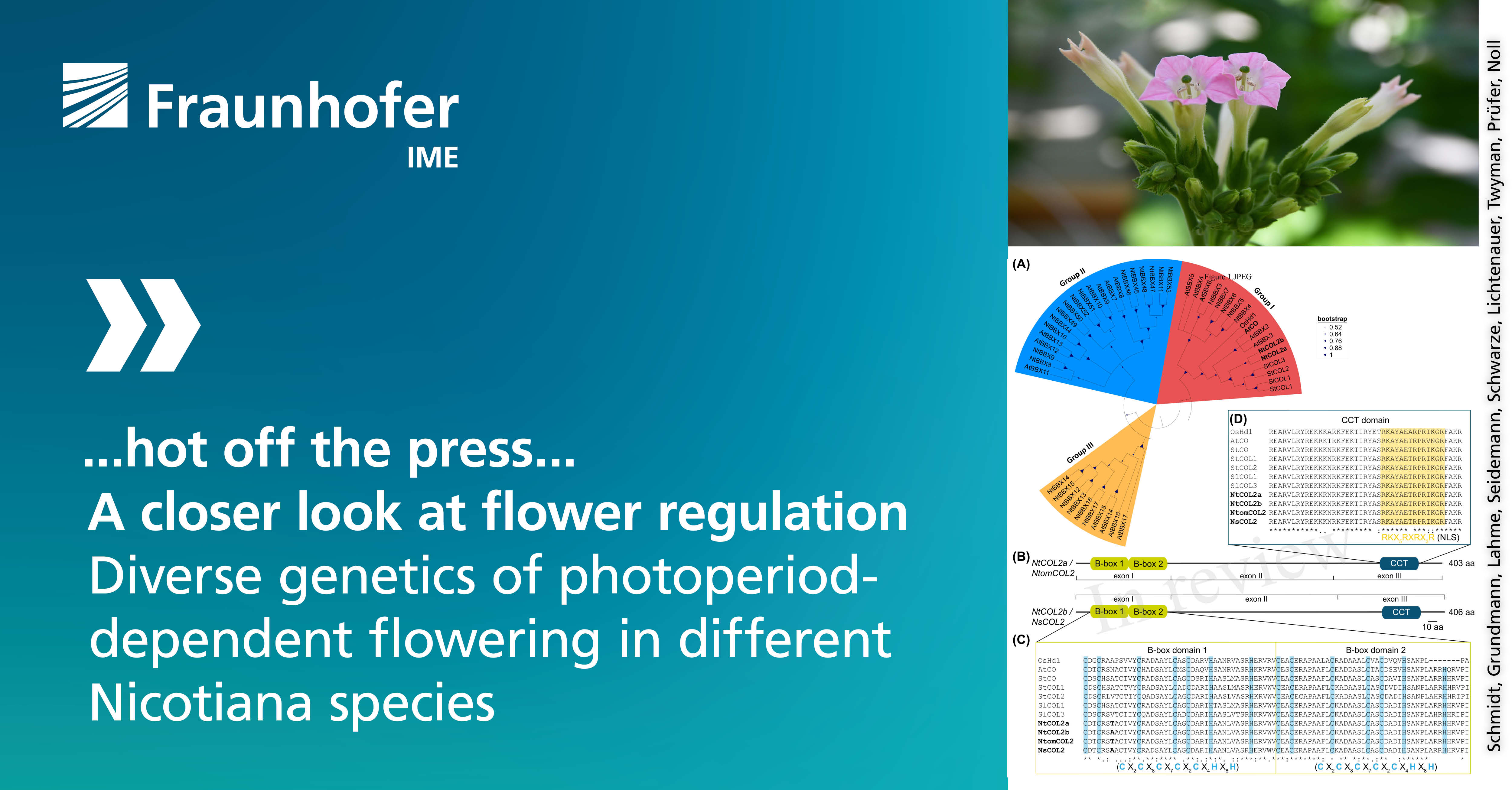Innovative Rubbers for More Sustainable Tires
Global efforts toward sustainable mobility are driving demand for tires with reduced emissions. This book chapter explores innovative rubber-based solutions that aim to minimize tire emissions. These solutions focus not only on reducing CO₂ emissions to address global warming, but also on reducing microparticle emissions resulting from tire abrasion. Two promising alternatives to conventional natural rubber are examined: (i) TARAXAGUM™, a sustainable natural rubber derived from the dandelion species Taraxacum koksaghyz, and (ii) BISYKA, a biomimetic synthetic rubber renowned for its exceptional abrasion resistance. Both options promise lower environmental impact while maintaining performance standards, which is especially important as upcoming regulations are expected to enforce stricter controls on tire emissions.
Publikationen
🌼 Unlocking the secrets of flowering in Taraxacum koksaghyz! 🌼
A recent study by Känel et al. explores the molecular mechanisms of flowering in the rubber-producing plant Taraxacum koksaghyz. Most T. koksaghyz plants require cold exposure to induce flowering, whereas vernalization-independent plants are more suitable for breeding. Therefore, a better understanding of the factors regulating flower development is needed.
The investigation revealed three FLOWERING LOCUS T (FT) homologs (TkFT1–3) that show different expression patterns under various environmental conditions.
Key findings:
❀ TkFT1 drives vernalization-independent flowering
❀ TkFT3, uniquely induced during cold exposure, is crucial for vernalization-dependent flowering
❀ Overexpression of TkFT1–3 can bypass the vernalization requirement, offering insights for future breeding strategies.
This study not only enhances our understanding of FT genes controlling flowering time but also paves the way for developing more efficient rubber crops.
Medicinal plants play an important role in biogenic value creation, especially in commercial cultivation, in order to meet the increasing global demand. This opens up new opportunities to improve harvest volumes through breeding and cultivation management. A crucial aspect of this is the determination of optimal times for harvesting, which depend on weather conditions and the condition of the plants. In this study, we investigated the medicinal plant Arnica montana ‘Arbo’ to analyze the yield of the target compounds helanalin and dihydrohelenalin and their esters in relation to the life cycle of the flower. A neural network was trained to classify seven developmental stages based on time-lapse images. Typical content values of the two target compound classes were determined for each flower type. By combining the results, the time courses of the active compounds could be calculated and better harvest time windows determined. This method is also interesting for other crops where external characteristics can serve as indicators for active compounds.
The latex of the Russian dandelion (Taraxacum koksaghyz) is a valuable source of natural rubber, but its metabolism and physiology have not yet been fully explored. Small rubber particle proteins stabilize rubber particles and are involved in stress responses. In a previous study (Wolters et al., 2024), the researchers identified geranylgeranyl reductase 1 - usually converting geranylgeranyl groups for chlorophyll production in chloroplasts - as a potential partner of small rubber particle protein 3. In this study, the team around Dr. Christian Schulze Gronover examined the specific role of geranylgeranyl reductase 1 in latex and its interaction with small rubber particle protein 3.
The team discovered that altering the levels of this enzyme affects tocopherol production in roots, but not rubber synthesis. Another geranylgeranyl reductase enzyme in leaves is responsible for chlorophyll production. They also noted the presence of geranylgeranyl diphosphate synthase and light-harvesting-like 3 protein in latex which interact with geranylgeranyl reductase 1 in chloroplasts.
In T. koksaghyz latex, geranylgeranyl reductase 1 is located in plastid-like structures, suggesting the existence of a new multi-protein complex that may help plants tolerate oxidative stress. Our study enhances our understanding of isoprenoid metabolism and the biology of natural rubber-producing cells in T. koksaghyz.
The study, combining expertise from the University of Stellenbosch, ARC Infruitec-Nietvoorbij and Fraunhofer IME, characterizes the composition of grape berry cuticular wax and identifies an amyrin synthase gene involved in triterpene biosynthesis. It reveals compositional differences between waxy phenotypes and during berry development, with a focus on two cultivars, 'Deckrot' and G1-7720.
Cuticular waxes of grape berries play a critical role in stress response and fruit quality. Understanding the compositional variation and the genetic mechanisms underlying grape berry cuticular wax formation remains limited. Therefore, the aim of this study was to characterize the composition of the cuticular waxes and to identify the genes involved in their biosynthesis.
The analysis revealed a shift from aldehyde to fatty acid accumulation during ripening, which also impacts resistance to Botrytis cinerea. Alcohols and aldehydes contribute to the glaucous wax appearance, while the triterpenoid oleanolic acid was identified as the most abundant wax monomer. Metabolic quantitative trait locus (QTL) analysis identified several genomic regions associated with wax monomer formation, including a triterpene cluster comprising eight putative triterpene synthases.
Further molecular phylogenetic analysis suggested that these genes code for amyrin synthesis. Co-expression and yeast expression studies confirmed the role of VvTTPS12 in oleanolic acid production, enhancing understanding of the genetic mechanisms behind grape berry wax composition.
A recent multidisciplinary study led by Dr. Alexandra Furch (University of Jena) in collaboration with apl. Prof. Dr. Gundula Noll and colleagues (Fraunhofer IME, Münster), along with further experts, explores how plants convert pathogen perception into electrical signals, triggering local and systemic defense responses. Surprisingly, the evidence indicates that sieve element occlusion proteins, previously thought to be mainly involved in phloem sealing, also contribute to the signal transmission process.
The team investigated Arabidopsis thaliana and Vicia faba, revealing that the density of the pathogen receptor (FLS2) is notably high in the epidermis and vascular parenchyma, while being low in the mesophyll and absent in sieve elements (SEs). Additionally, the findings highlighted dual cytosolic Ca2+ peaks shortly after recognition of the conserved microbial molecule (flg22), which correlated with voltage shifts from the epidermis to SEs. These electrical signals then manifest as rapid long-range action potentials (APs) or slower short-range variation potentials (VPs). The abundant Ca2+ influx linked to VPs caused transient sieve element occlusion (SEO) near the flg22 perception site, a phenomenon absent in the knockout mutants. The double knockout mutants (Atseor1/2) exhibited increased susceptibility to bacterial attacks from Pseudomonas syringae in comparison to wild-type plants, highlighting the importance of the SEO in plant defense mechanisms.
In their latest paper, our colleagues in Münster, together with Wolfgang Eisenreich (TUM) and Richard Twyman (TRM), focus on cis-prenyltransferases - a crucial enzyme family in the biosynthesis of linear isoprenoids.
The comprehensive analysis of the localization, interactions and products of the entire T. koksaghyz cis-PT family in vivo provides valuable insights into the regulation of isoprenoid metabolism in natural rubber-producing species. Notably, it reveals evidence of at least one previously unknown pentaprenol found exclusively in flowers.
In terms of broader impact, the results will enable the selection of targets for future experiments focusing on primary and secondary polyisoprenoid metabolites. Importantly, our study underscores the specialized nature of the T. koksaghyz rubber transferase complex, paving the way for the rational design of improved enzymes.
Russian dandelion (Taraxacum koksaghyz) is a promising source of natural rubber (NR). NR synthesis occurs on rubber particles found in latex, the cytoplasm of specialized laticifer cells. In addition to the enzymes involved in NR synthesis, rubber particles contain small rubber particle proteins (SRPPs), primarily SRPP3/4/5, which help maintain particle stability.
We identified 17 SRPP-like sequences in the T. koksaghyz genome, including three pseudogenes, 13 paralogs in a cluster, and one separate gene (TkSRPP6). The diversity in sequences and expression profiles suggested distinct functions, prompting us to investigate TkSRPP3/4/5 by affinity enrichment-mass spectrometry to identify their interaction partners in latex.
The results suggest that TkSRPP4 acts as a versatile hub protein binding to multiple partners, whereas TkSRPP3 and 5 have more specialized interactions. TkSRPP4 plays a special role in the endoplasmic reticulum, where it interacts with lipid-modifying enzymes that may aid in rubber particle formation. TkSRPP5 appears to be involved in GTPase-dependent signaling, and TkSRPP3 may be involved in a kinase signaling cascade related to stress tolerance. We also characterized two common interactors (TkSRPP6 and TkUGT80B1). In particular, the triterpenoid glycosylation activity of TkUGT80B1 provides the first evidence for triterpenoid saponin synthesis in T. koksaghyz latex. Our data advance the understanding of TkSRPP paralogs and their complex interactions, and shed light on the links between stress responses and NR biosynthesis in latex.
The dandelion plant Taraxacum koksaghyz shows great potential as a natural rubber source in the temperate climate zone. However, there are challenges in transforming it from a wild species into a crop plant. One obstacle is the need for most T. koksaghyz plants to undergo prolonged cold exposure also known as vernalization to trigger flower development.
In collaboration with partners, researchers at Fraunhofer IME in Münster used epigenomic and transcriptomic analysis to identify candidate genes involved in controlling flower development. Understanding the flowering time control in T. koksaghyz will facilitate the selection of varieties with shorter life cycles. These varieties can help to meet the growing demand for natural rubber.
In their recent publication, scientists at Fraunhofer IME in Münster, together with colleagues from the University of Münster and Humboldt University Berlin, demonstrated that the parasitic plant Cuscuta does not require the floral inducing proteins of the host, but produces its own floral activators.
The researchers used tobacco as host plant. First, they generated non-flowering tobacco host plants by mutating the two tobacco floral activators NtFT4 and NtFT5. They allowed C. campestris to parasitize wild-type tobacco and two independent Ntft4–Ntft5– T2 lines. The wild-type plants flowered after 66 days, whereas onset of flowering had not occurred in Ntft4–Ntft5– plants by the end of the experiment (83 days). C. campestris plants parasitizing wildtype tobacco flowered after 42 days, and those parasitizing the two double mutant hosts flowered after 39 and 42 days, respectively. Further studies on the endogenous FT-FD module and other floral regulators in C. campestris and C. australis provide deeper insights into flower regulation in these fascinating parasitic plants and will help to identify upstream regulators and downstream targets.
In plants, the switch from vegetative growth to flowering must be controlled to ensure reproduction occurs when the day length indicates the most suitable time of year.
In our latest paper we look at the key regulator of photoperiod-dependent flower development: CONSTANS (CO). In our model species Nicotiana tabacum, which flowers regardless of day length, we found two homologous genes and overexpressing or mutating these genes did not indicate a major involvement in the floral transition in tobacco. Related genes were also present in tobacco’s ancestors, one of which prefers to flower during short days while the other is restricted to long days. NsCOL2 overexpression in the long-day ancestor (Nicotiana sylvestris) allowed flowering under non-inductive short-day conditions. This correlated with the expression of NsFTd, a direct activator of flower development. These results contribute to the field by showing that NsFTd is transcriptionally activated by NsCOL2 in N. sylvestris but this function seems to be lost in tobacco, revealing an evolutionary mechanism contributing to the diverse photoperiod-dependent flowering in closely related species.
Becker J, Speldrich S, Wittstock G, Noll GA, Brand I
Controlled Mechanical Actuation of Adsorbed Forisome Mechanoproteins: A Step Toward Biomolecular Devices (2023)
Advanced Functional Materials, 2312159. DOI
Wolters SM, Benninghaus VA, Roelfs KU, van Deenen N, Twyman RM, Prüfer D, Schulze Gronover C
Overexpression of a pseudo-etiolated-in-light-like protein in Taraxacum koksaghyz leads to a pale green phenotype and enables transcriptome-based network analysis of photomorphogenesis and isoprenoid biosynthesis (2023) Frontiers in Plant Science. DOI
Riekötter, J, Oklestkova, J, Muth, J, Twyman, RM, Epping, J
Transcriptomic analysis of Chinese yam (Dioscorea polystachya Turcz.) variants indicates brassinosteroid involvement in tuber development (2023) Frontiers Nutrition DOI
Böttner, L, Malacrinò, A, Schulze Gronover, C, van Deenen, N, Müller, B, Xu, S, Gershenzon, J, Prüfer, D and Huber, M
Natural rubber reduces herbivory and alters the microbiome below ground (2023) New Phytologist DOI
Noll GA, Furch AC, Rose J, Visser F, Prüfer D
Guardians of the phloem–forisomes and beyond (2022) New Phytologist. DOI
Kalischuk M., Müller B, Fusaro A.F., Wijekoon C.P., Waterhouse P.M., Prüfer D., Kawchuk L.
Amplification of cell signaling and disease resistance by an immunity receptor Ve1Ve2 heterocomplex in plants (2022) Communications Biology, 5:497 DOI
Steinmaßl M., Boudaden J., Edgue G., Freund L.J., Meyer S., Mordehay N., Soto M., Endres H.-E., Muth J., Prüfer D., Lerch W., Kutter C.
Passivated Impedimetric Sensors for Immobilization-Free Pathogen Detection by Isothermal Amplification and Melt Curve Analysis (2022) Biosensors, 12(5):261 DOI
Känel P., Noll G.A., Schroedter K., Naffin E., Kronenberg J., Busswinkel F., Twyman RM, Klämbt C., Prüfer D.
The tobacco phosphatidylethanolamine-binding protein NtFT4 increases the lifespan of Drosophila melanogaster by interacting with the proteostasis network (2022) Aging DOI
Schnieder N., Känel A., Zimmermann M., Kriebs K., Witte A., Wrobel L.S., Twyman R.M., Prüfer D., Furch A.C.U., Noll G.A.
So similar yet so different: The distinct contributions of extrafascicular and fascicular phloem to transport and exudation in cucumber plants (2022) Journal of Plant Physiology, DOI
Rose J., Brand I., Bilstein-Schloemer M., Jachimska B., Twyman R.M., Prüfer D., Noll G.A.
The Ca2+ response of a smart forisome protein is dependent on polymerization (2022) Protein Science, DOI
Grundmann L, Känel A, Muth J, Beinecke F, Jekat M, Shen Y, Kudithipudi C, Xu D, Yang J, Warek U, Strickland J, Prüfer D, Noll GA
Tissue-specific expression of barnase in tobacco delays axillary shoot development after topping (2021) Plant Biotechnology Journal DOI
Kronenberg, J., Schrödter, K., Noll, G.A., Twyman, R.M., Prüfer, D., Känel, P.
The tobacco phosphatidylethanolamine-binding protein NtFT4 simultaneously improves vitality, growth, and protein yield in human cells (2021) Biotechnology and Bioengineering, 118 (10), 3770-3786. DOI
Wollenweber, T.E., van Deenen, N., Roelfs, K.-U., Prüfer, D., Gronover, C.S.
Microscopic and transcriptomic analysis of pollination processes in self-incompatible Taraxacum koksaghyz (2021) Plants, 10 (3), art. no. 555,1-17. DOI
Vasilev, H., Šmejkal, K., Gronover, C.S., Choi, Y.H., Prüfer, D., Jankovská, D., Ionkova, I.
Flavonol glycosides from aerial parts of Astragalus thracicus Griseb (2021) Phytochemistry Letters, 41, 119-122. DOI
Solís J.L., Muth J., Canales J., Lizana C., Prüfer D., Riegel R., Behn A.
Allelic diversity of three anthocyanin synthesis genes in accessions of native Solanum tuberosum L. ssp. tuberosum at the Potato Genebank of the Universidad Austral de Chile (2021) Genetic Resources and Crop Evolution, DOI
Rose, J., Müller, B., Groscurth, S., Giese, J., Eirich, J., Finkemeier, I., Twyman, R.M., Prüfer, D., Noll, G.A.
The functionality of plant mechanoproteins (forisomes) is dependent on the dual role of conserved cysteine residues (2021) International Journal of Biological Macromolecules DOI
Bröker, J.N., Müller, B., Prüfer, D., Gronover, C.S.
Combinatorial metabolic engineering in saccharomyces cerevisiae for the enhanced production of the fpp-derived sesquiterpene germacrene (2020) Bioengineering, 7 (4), art. no. 135, 1-13. DOI
Edgü, G., Freund, L.J., Hartje, S., Tacke, E., Hofferbert, H.-R., Twyman, R.M., Noll, G.A., Muth, J., Prüfer, D.
Fast, precise, and reliable multiplex detection of potato viruses by loop-mediated isothermal amplification (2020) International Journal of Molecular Sciences, 21 (22), art. no. 8741, 1-19. DOI
Benninghaus, V.A., Van Deenen, N., Müller, B., Roelfs, K.-U., Lassowskat, I., Finkemeier, I., Prüfer, D., Gronover, C.S.
Comparative proteome and metabolome analyses of latex-exuding and non-exuding Taraxacum koksaghyz roots provide insights into laticifer biology (2020) Journal of Experimental Botany, 71 (4), 1278-1293. DOI
Rose, J., Visser, F., Müller, B., Senft, M., Groscurth, S., Sicking, K.F., Twyman, R.M., Prüfer, D., Noll, G.A.
Identification and molecular analysis of interaction sites in the MtSEO-F1 protein involved in forisome assembly (2020) International Journal of Biological Macromolecules, 144, 603-614. DOI
Schmidt, F.J., Zimmermann, M.M., Wiedmann, D.R., Lichtenauer, S., Grundmann, L., Muth, J., Twyman, R.M., Prüfer, D., Noll, G.A.
The Major Floral Promoter NtFT5 in Tobacco (Nicotiana tabacum) Is a Promising Target for Crop Improvement (2020) Frontiers in Plant Science, 10, art. no. 1666. DOI
Pütter, K.M., van Deenen, N., Müller, B., Fuchs, L., Vorwerk, K., Unland, K., Bröker, J.N., Scherer, E., Huber, C., Eisenreich, W., Prüfer, D., Schulze Gronover, C. The enzymes OSC1 and CYP716A263 produce a high variety of triterpenoids in the latex of Taraxacum koksaghyz (2019) Scientific Reports, 9 (1), art. no. 5942. DOI
Niephaus, E., Müller, B., van Deenen, N., Lassowskat, I., Bonin, M., Finkemeier, I., Prüfer, D., Schulze Gronover, C.
Uncovering mechanisms of rubber biosynthesis in Taraxacum koksaghyz – role of cis-prenyltransferase-like 1 protein (2019) Plant Journal, 100 (3), 591-609. DOI
Van Deenen, N., Unland, K., Prüfer, D., Gronover, C.S.
Oxidosqualene cyclase knock-down in latex of Taraxacum koksaghyz reduces triterpenes in roots and separated natural rubber (2019) Molecules, 24 (15), art. no. 2703. DOI
Wieghaus, A., Prüfer, D., Gronover, C.S.
Loss of function mutation of the Rapid Alkalinization Factor (RALF1)-like peptide in the dandelion Taraxacum koksaghyz entails a high-biomass taproot phenotype (2019) PLoS ONE, 14 (5), art. no. e0217454. DOI
Bröker, J.N., Laibach, N., Müller, B., Prüfer, D., Schulze Gronover, C. Taraxacum brevicorniculatum rubber elongation factor TbREF associates with lipid droplets and affects lipid turn-over in yeast (2018) Biotechnology Reports, 20, art. no. e00290. DOI
Martínez, M.E., Poirrier, P., Prüfer, D., Schulze, C., Jorquera, L., Ferrer, P., Díaz, K., Chamy, R.
Kinetics and modeling of cell growth for potential anthocyanin induction in cultures of Taraxacum officinale G.H. Weber ex Wiggers (Dandelion) in vitro (2018) Electronic Journal of Biotechnology, 36, 15-23. DOI
Unland, K., Pütter, K.M., Vorwerk, K., van Deenen, N., Twyman, R.M., Prüfer, D., Schulze Gronover, C.
Functional characterization of squalene synthase and squalene epoxidase in Taraxacum koksaghyz (2018) Plant Direct, 2 (6), art. no. e00063 DOI
Laibach, N., Schmidl, S., Müller, B., Bergmann, M., Prüfer, D., Schulze Gronover, C.
Small rubber particle proteins from Taraxacum brevicorniculatum promote stress tolerance and influence the size and distribution of lipid droplets and artificial poly(cis-1,4-isoprene) bodies (2018) Plant Journal, 93 (6), 1045-1061. DOI
Bröker, J.N., Müller, B., van Deenen, N., Prüfer, D., Schulze Gronover, C.
Upregulating the mevalonate pathway and repressing sterol synthesis in Saccharomyces cerevisiae enhances the production of triterpenes. (2018) Appl Microbiol Biotechnol DOI
Stolze, A., Wanke, A., van Deenen, N., Geyer, R., Prüfer, D., Schulze Gronover, C.
Development of rubber-enriched dandelion varieties by metabolic engineering of the inulin pathway (2017) Plant Biotechnology Journal, 15 (6), 740-753. DOI
Pütter, K.M., van Deenen, N., Unland, K., Prüfer, D., Schulze Gronover, C.
Isoprenoid biosynthesis in dandelion latex is enhanced by the overexpression of three key enzymes involved in the mevalonate pathway (2017) BMC Plant Biology, 17 (1), art. no. 88. DOI
Visser, F., Müller, B., Rose, J., Prüfer, D., Noll, G.A.
Forizymes-functionalised artificial forisomes as a platform for the production and immobilisation of single enzymes and multi-enzyme complexes (2016) Scientific Reports, 6, art. no. 30839. DOI
Laibach, N., Post, J., Twyman, R.M., Gronover, C.S., Prüfer, D.
The characteristics and potential applications of structural lipid droplet proteins in plants (2015) Journal of Biotechnology, 201, 15-27. DOI
Martinez, M., Poirrier, P., Chamy, R., Prüfer, D., Schulze-Gronover, C., Jorquera, L., Ruiz, G.
Taraxacum officinale and related species - An ethnopharmacological review and its potential as a commercial medicinal plant (2015) Journal of Ethnopharmacology, 169, 244-262. DOI
Groscurth, S., Müller, B., Visser, F., Blob, B., Menzel, M., Rüping, B.A., Twyman, R.M., Prüfer, D., Noll, G.A.
Uncertain role of MtSEO-F3 in assembly of Medicago truncatula forisomes (2014) Plant Signaling and Behavior, 9 (JUN), art. no. e29581, e29581-1-e29581-3. DOI
Hwang, Y.T., Wijekoon, C., Kalischuk, M., Johnson, D., Howard, R., Prüfer, D., Kawchuk, L.
Evolution and Management of the Irish Potato Famine Pathogen Phytophthora Infestans in Canada and the United States (2014) American Journal of Potato Research, 91 (6), 579-593. DOI
Zielonka, S., Ernst, A.M., Hawat, S., Twyman, R.M., Prüfer, D., Noll, G.A.
Characterization of five subgroups of the sieve element occlusion gene family in Glycine max reveals genes encoding non-forisome P-proteins, forisomes and forisome tails (2014) Plant Molecular Biology, 86 (1-2), 51-67. DOI
Xing, S., Van Deenen, N., Magliano, P., Frahm, L., Forestier, E., Nawrath, C., Schaller, H., Gronover, C.S., Prüfer, D., Poirier, Y.
ATP citrate lyase activity is post-translationally regulated by sink strength and impacts the wax, cutin and rubber biosynthetic pathways (2014) Plant Journal, 79 (2), 270-284. DOI
Müller, B., Groscurth, S., Menzel, M., Rüping, B.A., Twyman, R.M., Prüfer, D., Noll, G.A.
Molecular and ultrastructural analysis of forisome subunits reveals the principles of forisome assembly (2014) Annals of Botany, 113 (7), 1121-1137. DOI
Post, J., Eisenreich, W., Huber, C., Twyman, R.M., Prüfer, D., Schulze Gronover, C.
Establishment of an ex vivo laticifer cell suspension culture from Taraxacum brevicorniculatum as a production system for cis-isoprene (2014) Journal of Molecular Catalysis B: Enzymatic, 103, 85-93. DOI
Fricke, J., Hillebrand, A., Twyman, R.M., Prüfer, D., Schulze Gronover, C. Abscisic acid-dependent regulation of small rubber particle protein gene expression in Taraxacum brevicorniculatum is mediated by TbbZIP1 (2013) Plant and Cell Physiology, 54 (4), 448-464. DOI
Groscurth, S., Müller, B., Schwan, S., Menzel, M., Diekstall, F., Senft, M., Kendall, A., Kommor, B.A., Neumann, U., Kalischuk, M., Kawchuk, L.M., Krzyzanek, V., Heilmann, A., Stubbs, G., Twyman, R.M., Prüfer, D., Noll, G.A.
Artificial forisomes are ideal models of forisome assembly and activity that allow the development of technical devices (2012) Biomacromolecules, 13 (10), 3076-3086. DOI
Bucsenez, M., Rüping, B., Behrens, S., Twyman, R.M., Noll, G.A., Prüfer, D.
Multiple cis-regulatory elements are involved in the complex regulation of the sieve element-specific MtSEO-F1 promoter from Medicago truncatula (2012) Plant Biology, 14 (5), 714-724. DOI
Richter, C., Dirks, M.E., Gronover, C.S., Prüfer, D., Moerschbacher, B.M.
Silencing and heterologous expression of ppo-2 indicate a specific function of a single polyphenol oxidase isoform in resistance of dandelion (Taraxacum officinale) against Pseudomonas syringae pv. tomato (2012) Molecular Plant-Microbe Interactions, 25 (2), 200-210. DOI
Jekat, S.B., Ernst, A.M., Zielonka, S., Noll, G.A., Prüfer, D.
Interactions among tobacco sieve element occlusion (SEO) proteins (2012) Plant Signaling and Behavior, 7 (12). DOI
Ernst, A.M., Rüping, B., Jekat, S.B., Nordzieke, S., Reineke, A.R., Müller, B., Bornberg-Bauer, E., Prüfer, D., Noll, G.A.
The sieve element occlusion gene family in dicotyledonous plants
(2011) Plant Signaling and Behavior, 6 (1). DOI
Rüping, B., Ernst, A.M., Jekat, S.B., Nordzieke, S., Reineke, A.R., Müller, B., Bornberg-Bauer, E., Prüfer, D., Noll, G.A.
Molecular and phylogenetic characterization of the sieve element occlusion gene family in Fabaceae and non-Fabaceae plants (2010) BMC Plant Biology, 10, art. no. 219. DOI
Ritter, E., Herran, A., Valdés-Infante, J., Rodríguez-Medina, N.N., Briceño, A., Fermin, G., Sanchez-Teyer, F., O'connor-Sanchez, A., Muth, J., Boike, J., Prüfer, D., Santos, C.A., Dos Santos, I.C.N., Rodrigues, M.A., Risterucci, A.M., Billotte, N., Becker, D., Rohde, W.
Comparative linkage mapping in three guava mapping populations and construction of an integrated reference map in guava (2010) Acta Horticulturae, 849, 175-182. DOI
Lepitre, V., Nansot, G., Grangeon, R., Pomies, V., Rivallan, R., Risterucci, A.M., Valdés-Infante, J., Rodríguez-Medina, N.N., Muth, J., Boike, J., Prüfer, D., Becker, D., Rohde, W., Ritter, E., Billotte, N.
The microsatellite (SSR)/AFLP reference linkage map of guava
(2010) Acta Horticulturae, 849, 183-192. DOI
Feller, G., Kugel, A., Moonshine, D., Chalifa-Caspi, V., Scholz, M., Prüfer, D., Rabinski, T., Müller, K.J., Ofir, R.
African descents are more sensitive than European descents to the antitumor compoundsα-hederin and kalopanaxsaponin i (2010) Planta Medica, 76 (16), 1847-1851. DOI https://doi.org/10.1055/s-0030-1250061
Noll, G.A., Rüping, B., Ernst, A.M., Bucsenez, M., Twyman, R.M., Fischer, R., Prüfer, D.
The promoters of forisome genes MtSEO2 and MtSEO3 direct gene expression to immature sieve elements in Medicago truncatula and Nicotiana tabacum (2009) Plant Molecular Biology Reporter, 27 (4), 526-533. DOI
Lipinski, M., Scholz, M., Pieper, K., Fischer, R., Prüfer, D., Müller, K.J.
A squalene epoxidase from Nigella sativa participates in saponin biosynthesis and mediates terbinafine resistance in yeast (2009) Central European Journal of Biology, 4 (2), 163-169. DOI
Scholz, M., Lipinski, M., Leupold, M., Luftmann, H., Harig, L., Ofir, R., Fischer, R., Prüfer, D., Müller, K.J.
Methyl jasmonate induced accumulation of kalopanaxsaponin I in Nigella sativa (2009) Phytochemistry, 70 (4), 517-522. DOI
Nickel, H., Kawchuk, L., Twyman, R.M., Zimmermann, S., Junghans, H., Winter, S., Fischer, R., Prüfer, D.
Plantibody-mediated inhibition of the Potato leafroll virus P1 protein reduces virus accumulation (2008) Virus Research, 136 (1-2), 140-145. DOI
Müller, K.J., He, X., Fischer, R., Prüfer, D.
Constitutive knox1 gene expression in dandelion (Taraxacum officinale, Web.) changes leaf morphology from simple to compound (2006) Planta, 224 (5), 1023-1027. DOI
Müller, K.J., Lin, J., Fischer, R., Prüfer, D.
How repeated epiphylly correlates with gene expression of resident knox1 in the leaves of tobacco epiphyllous shoots (2006) Central European Journal of Biology, 1 (2), 263-274. DOI
 Fraunhofer-Institut für Molekularbiologie und Angewandte Oekologie IME
Fraunhofer-Institut für Molekularbiologie und Angewandte Oekologie IME

